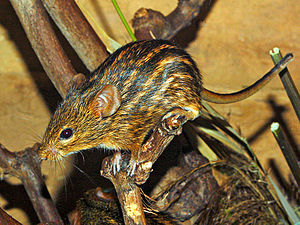Real striped grass mouse
| Real striped grass mouse | ||||||||||||
|---|---|---|---|---|---|---|---|---|---|---|---|---|

Real striped grass mouse |
||||||||||||
| Systematics | ||||||||||||
|
||||||||||||
| Scientific name | ||||||||||||
| Lemniscomys striatus | ||||||||||||
| ( Linnaeus , 1758) |
The True Stiff grass mouse ( Lemniscomys striatus ), also striped grass mouse or Tüpfelgrasmaus called, is a representative from the kind of striped grass mouse .
Appearance
The body length of the animals is 10 to 14 centimeters, that of the tail up to 15 centimeters and the weight between 20 and 70 grams. The animals have a long, slender body. The coat color is dark brown, on both sides and on the back the species has elongated, dark stripes, the middle stripe on the back is the darkest and extends to the base of the tail. The lower abdomen is light brown. The head is short with small ears and merges into the long nose. The front limbs are shorter than the rear. The animals in the western part of their range are lighter than their conspecifics in the eastern part.
Way of life
In their territory, the animals create beaten paths in order to get to food sources faster or to be able to flee from enemies more quickly. The grass vole eats grass, leaves, fruits and insects. The animals are very scared and jump in danger. If an enemy grabs them, they will either pretend to be dead or remove the skin on their tail to escape.
distribution
This species occurs in the savannah landscapes of East and West Africa.
Reproduction
Several litters a year are possible. After a gestation period of 21 to 25 days, the female gives birth to several young. According to various sources, the litter size is given as 1 to 7 young animals. The average number of youngsters per litter is between 2.75 and 5.54. The newborns are initially naked, deaf and blind. The fur tips come out of the skin after a few days. The eyes open after about two weeks. The young are suckled for about four weeks and are completely independent after 30 days.
Danger
Since this species is widespread and also occurs in protected areas, the IUCN classifies it as “ Least Concern ” .
supporting documents
- ↑ Litter size spotted grass mice . In: Small mammals sui generis . October 6, 2016 ( jimdo.com [accessed May 3, 2018]).
- ↑ Spotted grass mice. Retrieved on May 3, 2018 (German).
literature
- Wilhelm Eigener (Ed.), Erna Mohr: Encyclopedia of Animals. Volume 2, Weltbild, Augsburg 1991, ISBN 978-3-89350-361-2 , p. 435.
- Encyclopedia of Mammals. Könnemann 2003, ISBN 3-89731-928-4 , pp. 641, 643.
- David Burnie (Ed.), Mariele Radmacher-Martens: Animals: The large picture encyclopedia with over 2,000 species. Translated from the English by Gabriele Lehari. Dorling Kindersley, Munich 2012, ISBN 978-3-8310-2232-8 , p. 127.
Web links
- Lemniscomys striatus inthe IUCN Red List of Threatened Species 2014.3. Posted by: van der Straeten, E., Decher, J., Corti, M. & Abdel-Rahman, EH, 2008. Accessed November 19, 2014.